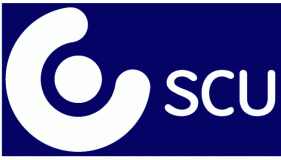Blog Archives
MSc projects: science communication research in the real world
Clare Wilkinson
During our MSc Science Communication at UWE Bristol we focus a lot of effort on supporting students to develop their networking and employability skills whilst they study our modules. That’s one of the reasons why our graduates seem to be pretty successful in finding a job in science communication after studying with us and it also means our students get to meet a wide range of science communication practitioners and academics who are working at the ‘coalface’.
One way in which we build in an opportunity to work with an external organisation is via our Science Communication project module. Since the programme started 15 years ago we’ve had well over 150 students working on projects with our Unit and in 2009 we introduced a specific opportunity for students to conduct their projects in partnership with an external organisation. This has resulted in collaborative projects with organisations and charities including We The Curious, the Durrell Wildlife Conservation Trust, Public Health England, and the British Science Association to name just a few. As our current students complete their projects we spoke to some of the students working with external organisations this year about their experiences.

Anastasia Voronkova
Anastasia Voronkova, joined our programme from her home in Russia in September 2016. Anastasia said ‘in my project, I am analysing Durrell Wildlife Conservation Trust’s, one of the biggest international charities’, Facebook, Twitter and Instagram social media strategies and trying to understand how the audiences on these websites perceive conservation related posts.’ Digital and social media communication have been popular topics for our project students in recent years, and it’s also a space where many organisations are still finding their way, or coming up with contemporary and new approaches to reach audiences.
Anastasia was pleased to have chosen to work with an external organisation, who had been offering ‘great help and support’ alongside her UWE supervisor. Anastasia said her project had also ‘given me a unique opportunity to gain some knowledge about conservation from its active practitioners and to contribute to that field, even if only in the form of a research.’

Lindsey with some of her participants
Lindsey Cooper is a part-time student who began studying her MSc in September 2014 whilst working as an outreach and recruitment officer at Plymouth University. Lindsey has been working with We The Curious (formerly At-Bristol) on her MSc project, which offered exciting opportunities to explore not only the combination of art and science but also the relationship of science centres to underserved audiences, in her case those with physical disabilities. Lindsey said: ‘I have been evaluating a new exhibit called The Box, to see if people with physical disabilities interact and respond to the exhibit in the same way as individuals without a disability.’ The Box celebrates the synergy between art and science, and feature exhibitions and artists that occupy the space where art and science meet.
‘I have really enjoyed the experience of working with an external organisation on my project’, said Lindsey, ‘but involving more individuals has (inevitably) made the process more lengthy and complex. It took me a while to develop my research question and balance what I was interested in with what was useful to the exhibit designers at We The Curious. However, I feel like I’ve ended up with a stronger research question and results than I would have otherwise.’

Ben Sykes on site at Steart Marshes
Ben Sykes was also working whilst undertaking his MSc, though in his case this involved him developing his freelance writing career, following a change of direction after many years working at Research Councils. Ben worked with the WWT Steart Marshes which is a created wetland in Somerset. Ben said ‘this is one of the largest and most ambitious managed coastal realignment projects ever undertaken in the UK’ and the project provided him with a real opportunity to get on site at with the WWT, and to consider the issues they face in ‘communicating the science behind its creation and the ongoing research being conducted there by a consortium of universities.’
Ben described his project as a ‘huge challenge’ communicating in an outdoor, remote environment but by creating three Quick Response (QR) codes which were deployed across the reserve, Ben was able to see some real impacts from his work. Ben continued ‘By linking this to web-based science content, my project resulted in a third of Steart Visitors accessing content on the web and learning something about science. It was a super project to work on.’
Our thanks to all organisations who contribute their time and ideas to work with our students, as well as Ben, Lindsey and Anastasia for their contributions to this blog post. If you are based at an organisation who would like to work with student projects in future please contact Clare.Wilkinson@uwe.ac.uk. Find out more about our Science Communication programmes.
Shall we talk about robots and public engagement? Ten years on.
2017 marks the ten-year anniversary since I started working on the Talking Robots project with my former SCU colleagues Karen Bultitude and Emily Dawson. A lot has been happening in robotics since then (you can read a quick summary of some key developments from the last ten years in Robotics Trends) but at the time we were interested in two key questions; What were people’s attitudes towards robotic technologies, and how were publics being engaged around these developments?
Ten years on it’s interesting to consider how many findings from this project are still relevant to public engagement. In one journal article based on this project we took the chance to explore the perspectives of the engagers and researchers involved in a series of different types of public engagement events regarding robotics in a bit more detail. The article ‘Oh yes, robots! People like Robots; the Robot people should do something’, is full of information on some of the benefits and constraints engagers identified in their work. Expectations, organisational aspects and practical issues could have a considerable impact on engagement events, but there were also signs that, a decade ago, engagers were feeling more supported and prepared to engage, and conscious of a desire amongst people to ask questions, not only to learn. We also found that definitions of public engagement, which some have more recently described as a ‘buzzword’, were by no means fixed:
‘Scientists do not operate with one definition of public engagement (Davies, 2008), instead moving between flexible, diverse and disjointed notions suggesting that ‘engagers’, ‘organisers’ and ‘audiences’ alike will change their engagement agendas if and when controversies arise.’ (Wilkinson, Bultitude and Dawson, 2010).
Alongside those seeking to engage, we were also interested in finding out a bit more about the people who participate in public engagement activities focused on robotics. In our article ‘Younger people have like more of an imagination, no offence’ we wanted to know more about why people, publics, you and me, were engaging, where they came from and what they wanted to achieve. This is something researchers are still interested in today. The recent National Academies of Sciences, Engineering and Medicine report ‘Communicating Science Effectively’ highlights that people’s ‘needs and opinions’ can change and thus, over time, effective communication must also be ‘iterative and adaptable’, perhaps no more so than in 2017.
Looking back to 2007 we found that there were lots of reasons why people were attending their local science centre, visiting a science café or participating in a school workshop. Some were attracted by the subject matter, others because it was part of their usual routines. And whilst they often empathised with the researchers they interacted with, they also had clear expectations of them and individual hopes as to what they would gain from an experience. But there were challenges:
‘Participants often struggled to identify how members of the public might participate and contribute their view in engagement settings, though often there was an underlying perception that engagement was considered ‘citizenly’. They identified that certain subjects had a greater relevance to public participation than others, in particular those with societal relevance… The challenge for those engaging publics is thus to effectively communicate the aims of such activities and appreciate the differing notions of role and participation that may exist amongst their participants.’ (Wilkinson, Dawson and Bultitude, 2012).
Some, more recent studies, continue to explore these themes, such as Gehrke’s (2014) interest in ‘existing publics’, and of course, there is now the added edge of the role of public engagement in ‘post truth politics’.
So ten years on are these issues still relevant? In my view, it’s a yes, and yes. We can still learn more about how researchers consider, engage and communicate around their work, particularly as research agendas shift and change, and the culture of engagement matures. And there’s always more to understand about people, how and why they participate, as well as why they don’t. As for robotics itself, there will also of course, be ever emerging developments, some of which will pose philosophical, ethical and social questions in the future. Are we still interested in ‘Talking Robots’, I think so.
Clare Wilkinson
Both Talking Robot articles are openly available via the UWE Research Repository:
http://eprints.uwe.ac.uk/15336/8/Manuscript%20-%20Oh%20Yes%20the%20Robots.pdf
Talking Robots was funded by the ESRC (RES-000-22-2180).
Baby-led, puree, Annabel Karmel and me? When science impacts on the choices we make in parenting
How we make choices as consumers, patients, parents and members of the public has, of course, long been of interest to science communicators, and topics like immunisation can continue to raise differences in perspectives, as well as media interest. A few years ago we started to think about the sometimes challenging process of weaning a baby. Ruth had recently had two young children herself, whilst completing her MSc Science Communication with us, and I’d been doing some research with parents and caregivers in community groups, so we knew weaning was a topic that was being discussed. But what about the parents who might not be out there in these social spaces, what was happening online? We asked the question ‘how do people on Mumsnet frame media coverage of weaning?’
As our starting point we considered a review of scientific evidence published in the British Medical Journal in 2011. This work, by Fewtrell and colleagues, suggested the period of exclusive breastfeeding recommended by the World Health Organisation be reduced from six months to four. Unsurprisingly the study attracted media attention, particularly in ‘quality’ newspapers like The Times, The Guardian, and especially, The Telegraph, and was frequently reported on by specialist health and science correspondents. They tended to talk about ‘risk’ but rarely contextualised that with further information on the study itself.
On Mumsnet it was clear that a vibrant community was keen to discuss the issue of weaning, and we located 112 comments that directly referred to the Fewtrell example and its media coverage. What were people most wanting to talk about? The inaccuracy of media coverage really stood out in their comments, as well as frustration that it was returning to the breast vs. bottle aspects of the debate. And the forum discussions often presented more context, nuances around the question of ‘risk’ and the details of the study itself. Of course, they had more room to do so, but it was interesting to see these types of details being discussed.
What does this tell us about science, the media and how it’s discussed online? Well it suggests that at least amongst this very small sample of Mumsnet users there is some awareness of the weaknesses that can be present in science and health reporting, but also that people often use scientific and personal information in transitionary means, embellishing some of the deficiencies of media coverage in interesting and new ways. As people become more and more reliant on social media sources for information, further work is needed on how this is supplementing and challenging our relationships with scientific and medical expertise but also how we use our social networks to support decision making. You can find out more about this work in a recent Journalism article or at:
http://eprints.uwe.ac.uk/27843/3/The_Worries_of_Weaning_paper_10_10_15%20-%20Copy.pdf
Clare Wilkinson and Ruth Knowles
Communicating research: do we need to be more creative?
Clare Wilkinson and Emma Weitkamp are Associate Professors based at the Science Communication Unit, University of the West of England, Bristol.
A press release and tracking of the resultant media coverage, or a public talk, are relatively easy methods of public communication, which most researchers are comfortable adding to their pathways to impact, but what about those wanting to be a bit more adventurous or wishing to undertake public engagement right from the start to help shape research design or data collection? In our new book Creative Research Communication: Theory and Practice, we explore a range of emerging or non-traditional approaches that the research community is exploring for public communication and engagement; from collaboration with the arts, to digital storytelling and gaming, through to the use of comedy in locations like community spaces and festival sites.
By considering an array of different research communication opportunities, we argue that researchers may find compelling niches for both themselves and their research participants, to engage creatively alongside, or perhaps despite, increasing institutional agendas around engagement:
‘This is an era to channel creatively away from metrics or “one size fits all” and to engage in ways that work for you as an individual researcher in the context of your own disciplinary potential and desires, and that embrace and recognise the ways that people beyond the context of an organisation or university may creatively add to your research process as well as experience benefits of their own.’ (Wilkinson and Weitkamp, p.10)
We’re not suggesting in the book that all approaches to research communication need to be entirely new or novel, rather that there is a rich history of research communication which can be drawn on to develop effective, insightful and engaging approaches. Starting with a history of the field, and moving through chapters examining many tried and tested approaches, we offer the novice research communicator a set of tools and ideas via which they may build and advance their practice, often using more recent or contemporary techniques.
The book is peppered with case studies drawn from around the world; you can read up on how researchers are embedding art at CERN, using apps to allow people to experience their city in roman times via the Virtual Romans project, and supporting communities to tackle their local environmental worries through the Public Lab approach. Most chapters are supported by clear advice on practical aspects of research communication, for instance there are sections on how to utilise audience segmentation approaches, manage conflict and controversy, and principles to keep in mind when working with policymakers.
In writing the book we tried to keep a range of research areas firmly in view. As co-authors coming from two contrasting disciplines (originally working in sociology and biochemistry) we tried to consider a range of ways in which research communication can and may be relevant, and that for some researchers this may be at different points of the research journey:
‘From a research communication perspective, and particularly conversations around “impact”, there can be a tendency to focus on engagement after the fact, rather than before or during research. This neglects that whilst research has an impact on people, people also have an impact on research.’ (Wilkinson and Weitkamp, p.74)
And whilst we’ve titled the book Creative Research Communication, don’t be deceived that we see communication as only occurring in a one-directional manner. We envisage communication to include a variety of approaches, including those which embed people within research and engagement, from a participatory and dialogic perspective.
But of course impact is a very relevant issue for many research communicators at present and it can stimulate particular notions of the direction of any such impact. Recognising that, we have included a chapter on impact, which contains evaluation approaches which can be used to track the outcomes and impacts of your research communication activities on a range of participants including the researcher, as well as ways in which you might adapt evaluation to be more creative in itself. For us impact is also tied to ethical quandaries around the wider role of research communication. Is research communication about engendering change, learning, attitudes that align to our ways of thinking? Is it for all but really for some? Does research communication in and of itself need an ethical code of practice? We explore some of these themes within the book, as well as providing resources to equip researchers with techniques for ethical best practice in the design and evaluation of their research communication efforts.
In summary, we hope that the book provides a space for researchers to reflect on the ways they can engender creativity in their own research communication efforts, whilst recognising that taking such ‘risks’ requires support and encouragement:
‘Creativity can involve taking risks, having failures, pushing beyond one’s boundaries, and evaluation is one space in which to capture this, continuing to move the trajectory of research communication forwards without simply reducing research communication activities to those which might tick a box. Creative research communication is a recipe, concoction, a craft and a science, and it is up to each researcher to consider where their path lies on their own map of research communication.’ (Wilkinson and Weitkamp, p.266).
To answer our original question, do we need to be more creative in communicating research, not necessarily, but we hope the book provides a wide variety of reasons why you can.
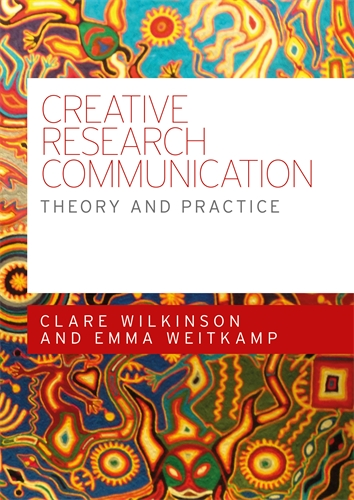
What happens to sci comms graduates?
Lots of people are interested to find out what our Masters in Science Communication and Postgraduate Certificate in Practical Science Communication students at UWE, Bristol get up to when they leave us. As the infographic shows, it’s pretty impressive. We’re currently advertising part-bursaries to study with us in 2016/17, if you’d like more info contact Clare.Wilkinson@uwe.ac.uk
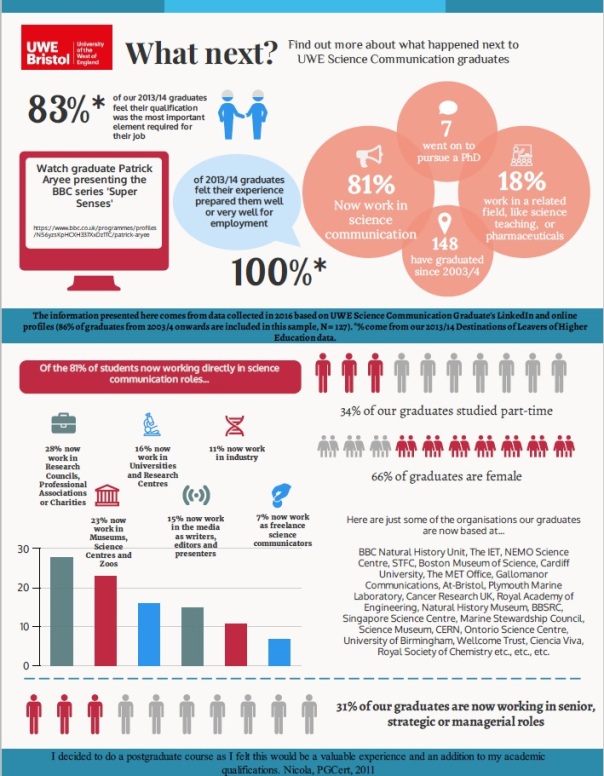
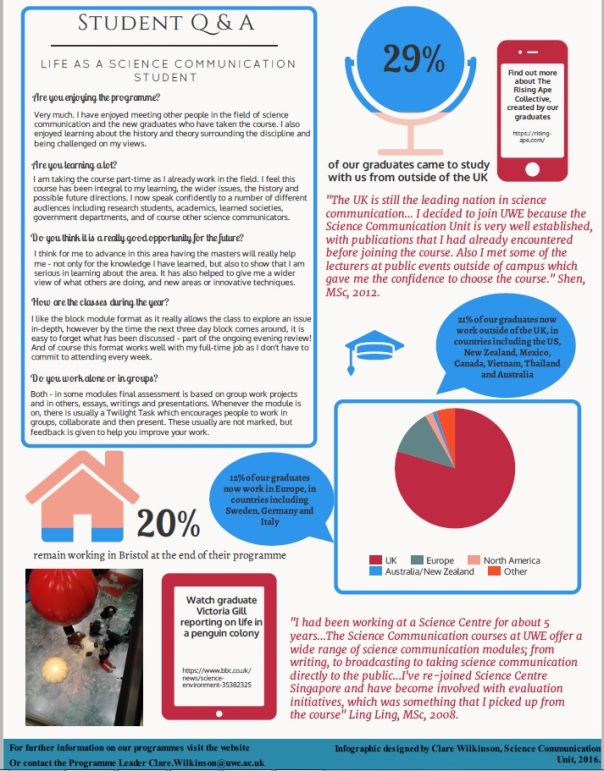
You can download a pdf of this infographic: Sci Comm UWE Graduate Destination Infographic 2016
Clare Wilkinson, the programme leader, will be presenting some of this information at next week’s PCST Annual Conference.
Masters and beyond with the SCU
Clare Wilkinson explains some of the programmes that UWE Bristol offers in Science Communication, and how coming back to school builds towards the ‘university of life.’
This year we had around 25 new students joining us to start our MSc Science Communication programme and Postgraduate Certificate in Practical Science Communication.
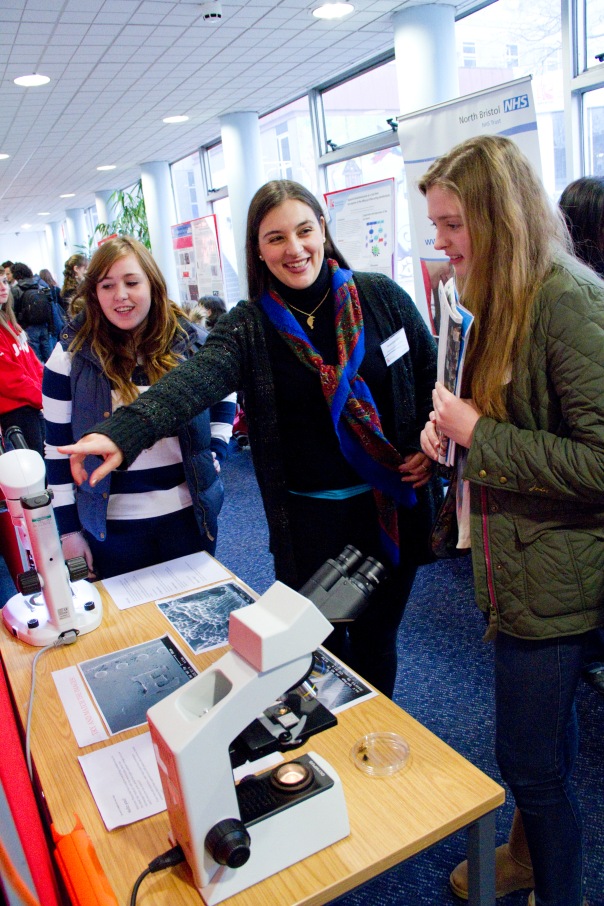
MSc student discusses a project during a UWE open day
At postgraduate level we work with students in a number of ways. Most students join our MSc Science Communication programme, as either a full or part-time student. Running for over ten years this programme has developed an excellent reputation for its combination of theory and practice. This means it continues to attract both those who have just completed a university degree and have already made the decision that their future lies in science communication, as well as students who have been working in a related field for a while and either are looking to make a career transition or to firmly establish a more formal qualification.
Running for over ten years this programme has developed an excellent reputation for its combination of theory and practice.
We also have a smaller number of students who take our Postgraduate Certificate in Practical Science Communication. Typically students on this programme tend to be practicing researchers who have been communicating their own research alongside their ‘day job’ and are looking to develop that experience further. On similar lines we also have a number of PhD students, from a wide range of areas at UWE, who are taking one or two of our science communication modules as part of their PhD programme. It’s fantastic to see early career researchers identifying a role for communication and engagement and building this into their research from the outset.
I tend to think about the programme in three ways; as ‘back to school’, the ‘light bulb’ moment and the ‘university of life’.
Back to school
As programme leader I tend to be in touch with our new students a lot, even before they start their courses. I’ll be confirming people’s module choices, double checking they are on the right programme and often having last minute meetings to let new students, and sometimes their families, get a feel for our campus and team.
Deciding to undertake postgraduate study is a big commitment, intellectually but also from a time and financial perspective, and so it’s understandable that often our students, their partners and families can feel a little nervous about it. I vividly remember once having to explain the potential job prospects of our course to an applicant’s father. Science communication was new to him and he wanted to be 100% sure it would offer his science graduate son a potential route to his desired employment in the future. I’m also well practiced in finding the odd coloured pen or piece of paper for a restless five-year old accompanying their parent to a UWE open evening, with very little interest in the new MSc their caregiver is about to undertake.
Any fearfulness will turn to smiles. A realisation takes hold that they have found a place where everyone shares their interests.
So, whatever the age, circumstances or commitments of our new students, starting a postgraduate programme will often mean change, uncertainty and challenges. My aim is that by the first day all new students feel confident that they have made the right decision for them, so that the ‘back to school’ feeling is one they (and their families) can embrace.
The light bulb moment
The start of the programme is always really busy, and this year was no different. Amongst registration activities, introductions to the library and the practicalities of life as a UWE student we also try to fit in content about life as a science communicator, and importantly, lots of opportunities for our students to meet and talk with each other. You only need to look around the room on the first day to realise that people are feeling nervous, anticipating what they will have in common with their new peers and eyeing up those they might potentially be friends with. This brings me to the light bulb moment.
We get introductions happening straight away… ‘Tell us about yourself’, I will say to each person, ‘just some snippets about you, where you are from and why you are here’. It’s then that it starts, each person around the room expressing their passion for communicating, that they love their subject (whatever that might be – we don’t only accept only science-based students on our programme), but that they think their real strengths lie in engaging around it. And one after another, any fearfulness will turn to smiles. A realisation takes hold that they have found a place where everyone shares their interest in communicating and that this will be their home for the coming weeks, months or years.
The university of life
On the first day, we distribute module guides and assessment information, talk about the various disciplines that influence science communication, and outline the expected level of reading. It will become clear that no student can learn all that there is to know about science communication in the first days or weeks of teaching and that much, much more is to come. As one door has closed on their undergraduate studies, the possibilities at Masters level can seem endless. It can be overwhelming, but as with the start of any new project the possibilities are exciting.
If you are interested in finding out more about the UWE Bristol Science Communication Masters or Postgraduate Certificate, please go to our website.


